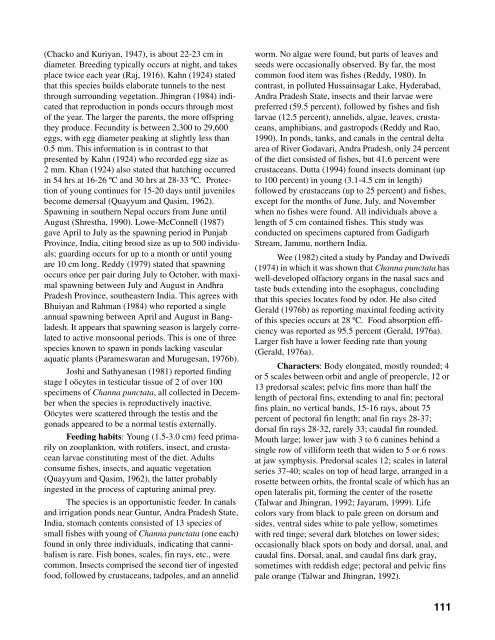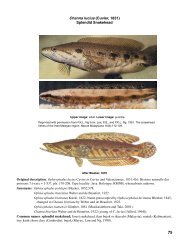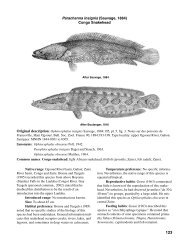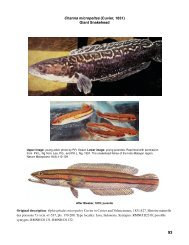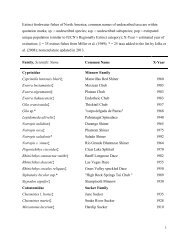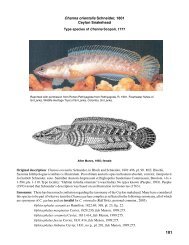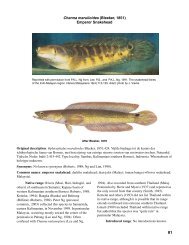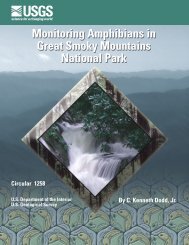Channa pleurophthalma (Bleeker, 1851) Ocellated Snakehead
Channa pleurophthalma (Bleeker, 1851) Ocellated Snakehead
Channa pleurophthalma (Bleeker, 1851) Ocellated Snakehead
- No tags were found...
Create successful ePaper yourself
Turn your PDF publications into a flip-book with our unique Google optimized e-Paper software.
(Chacko and Kuriyan, 1947), is about 22-23 cm indiameter. Breeding typically occurs at night, and takesplace twice each year (Raj, 1916). Kahn (1924) statedthat this species builds elaborate tunnels to the nestthrough surrounding vegetation. Jhingran (1984) indicatedthat reproduction in ponds occurs through mostof the year. The larger the parents, the more offspringthey produce. Fecundity is between 2,300 to 29,600eggs, with egg diameter peaking at slightly less than0.5 mm. This information is in contrast to thatpresented by Kahn (1924) who recorded egg size as2 mm. Khan (1924) also stated that hatching occurredin 54 hrs at 16-26 ºC and 30 hrs at 28-33 ºC. Protectionof young continues for 15-20 days until juvenilesbecome demersal (Quayyum and Qasim, 1962).Spawning in southern Nepal occurs from June untilAugust (Shrestha, 1990). Lowe-McConnell (1987)gave April to July as the spawning period in PunjabProvince, India, citing brood size as up to 500 individuals;guarding occurs for up to a month or until youngare 10 cm long. Reddy (1979) stated that spawningoccurs once per pair during July to October, with maximalspawning between July and August in AndhraPradesh Province, southeastern India. This agrees withBhuiyan and Rahman (1984) who reported a singleannual spawning between April and August in Bangladesh.It appears that spawning season is largely correlatedto active monsoonal periods. This is one of threespecies known to spawn in ponds lacking vascularaquatic plants (Parameswaran and Murugesan, 1976b).Joshi and Sathyanesan (1981) reported findingstage I oöcytes in testicular tissue of 2 of over 100specimens of <strong>Channa</strong> punctata, all collected in Decemberwhen the species is reproductively inactive.Oöcytes were scattered through the testis and thegonads appeared to be a normal testis externally.Feeding habits: Young (1.5-3.0 cm) feed primarilyon zooplankton, with rotifers, insect, and crustaceanlarvae constituting most of the diet. Adultsconsume fishes, insects, and aquatic vegetation(Quayyum and Qasim, 1962), the latter probablyingested in the process of capturing animal prey.The species is an opportunistic feeder. In canalsand irrigation ponds near Guntur, Andra Pradesh State,India, stomach contents consisted of 13 species ofsmall fishes with young of <strong>Channa</strong> punctata (one each)found in only three individuals, indicating that cannibalismis rare. Fish bones, scales, fin rays, etc., werecommon. Insects comprised the second tier of ingestedfood, followed by crustaceans, tadpoles, and an annelidworm. No algae were found, but parts of leaves andseeds were occasionally observed. By far, the mostcommon food item was fishes (Reddy, 1980). Incontrast, in polluted Hussainsagar Lake, Hyderabad,Andra Pradesh State, insects and their larvae werepreferred (59.5 percent), followed by fishes and fishlarvae (12.5 percent), annelids, algae, leaves, crustaceans,amphibians, and gastropods (Reddy and Rao,1990). In ponds, tanks, and canals in the central deltaarea of River Godavari, Andra Pradesh, only 24 percentof the diet consisted of fishes, but 41.6 percent werecrustaceans. Dutta (1994) found insects dominant (upto 100 percent) in young (3.1-4.5 cm in length)followed by crustaceans (up to 25 percent) and fishes,except for the months of June, July, and Novemberwhen no fishes were found. All individuals above alength of 5 cm contained fishes. This study wasconducted on specimens captured from GadigarhStream, Jammu, northern India.Wee (1982) cited a study by Panday and Dwivedi(1974) in which it was shown that <strong>Channa</strong> punctata haswell-developed olfactory organs in the nasal sacs andtaste buds extending into the esophagus, concludingthat this species locates food by odor. He also citedGerald (1976b) as reporting maximal feeding activityof this species occurs at 28 ºC. Food absorption efficiencywas reported as 95.5 percent (Gerald, 1976a).Larger fish have a lower feeding rate than young(Gerald, 1976a).Characters: Body elongated, mostly rounded; 4or 5 scales between orbit and angle of preopercle, 12 or13 predorsal scales; pelvic fins more than half thelength of pectoral fins, extending to anal fin; pectoralfins plain, no vertical bands, 15-16 rays, about 75percent of pectoral fin length; anal fin rays 28-37;dorsal fin rays 28-32, rarely 33; caudal fin rounded.Mouth large; lower jaw with 3 to 6 canines behind asingle row of villiform teeth that widen to 5 or 6 rowsat jaw symphysis. Predorsal scales 12; scales in lateralseries 37-40; scales on top of head large, arranged in arosette between orbits, the frontal scale of which has anopen lateralis pit, forming the center of the rosette(Talwar and Jhingran, 1992; Jayaram, 1999). Lifecolors vary from black to pale green on dorsum andsides, ventral sides white to pale yellow, sometimeswith red tinge; several dark blotches on lower sides;occasionally black spots on body and dorsal, anal, andcaudal fins. Dorsal, anal, and caudal fins dark gray,sometimes with reddish edge; pectoral and pelvic finspale orange (Talwar and Jhingran, 1992).111


